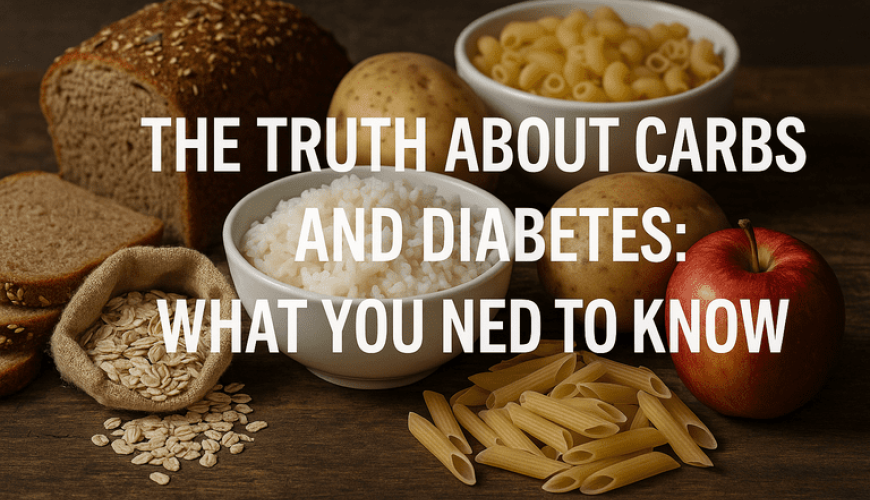
When it comes to managing diabetes, few topics stir as much confusion as carbohydrates. Some say eliminate them altogether, while others emphasize moderation and smarter choices. The truth lies in understanding how different carbohydrates affect your blood sugar, which carbs are most beneficial, and how to incorporate them into a healthy diet without causing glucose spikes. In this in-depth article, we uncover the real relationship between carbs and diabetes—and how to manage it wisely.
wisely.
What Are Carbohydrates and How Do They Affect Blood Sugar?
Carbohydrates are one of the three macronutrients, along with fats and proteins. They are the body’s primary source of energy, and they directly impact blood glucose levels more than any other nutrient.
Carbohydrates are broken down into glucose during digestion, which enters the bloodstream and raises blood sugar. This spike in blood sugar is managed by insulin, a hormone produced by the pancreas. In people with diabetes, the body either doesn’t produce enough insulin or cannot use it effectively, leading to elevated blood sugar levels.
Types of Carbohydrates: Not All Carbs Are Created Equal
There are three main types of carbohydrates:
1. Sugars (Simple Carbohydrates)
These are rapidly digested and can cause immediate spikes in blood sugar. Found in:
Table sugar
Soda and sugary drinks
Candy and pastries
Fruit juices (especially without pulp)
2. Starches (Complex Carbohydrates)
These are made of longer chains of glucose and digest more slowly:
Whole grains (brown rice, oats, barley)
Starchy vegetables (sweet potatoes, corn, peas)
Legumes (beans, lentils)
3. Fiber
Fiber is a type of carbohydrate that does not raise blood sugar. It actually helps slow digestion, supports gut health, and improves insulin sensitivity:
Vegetables
Fruits with skin or pulp
Whole grains
Nuts and seeds
Understanding Glycemic Index (GI) and Glycemic Load (GL)
Glycemic Index (GI):
A scale from 0 to 100 that ranks foods based on how quickly they raise blood glucose.
Low GI: 55 or less
Medium GI: 56–69
High GI: 70 or more
Glycemic Load (GL):
Takes into account both the GI and the quantity of carbs in a serving. This provides a more accurate picture of how a food affects blood sugar.
Foods with low GI and low GL are ideal for managing diabetes, as they result in gradual rises in blood sugar, reducing the burden on insulin production.
The Role of Carbohydrates in a Diabetes-Friendly Diet
Carbs are not the enemy—but choosing the right types and consuming them in controlled portions is essential.
Benefits of Smart Carb Consumption:
Maintains stable energy levels
Supports brain function
Aids digestion through fiber
Promotes heart health when sourced from whole grains and legumes
How Many Carbs Should People with Diabetes Eat?
There’s no one-size-fits-all approach. The appropriate amount of carbs depends on:
Age and gender
Activity level
Weight goals
Medication use
Blood sugar targets
A typical guideline is 45–60 grams of carbohydrates per meal, but some individuals may need more or less. It’s best to work with a healthcare provider or dietitian to personalize your plan.
Best Carbohydrate Sources for Diabetes
Focus on whole, nutrient-dense carbs that digest slowly and provide fiber, vitamins, and minerals:
Non-starchy vegetables: spinach, broccoli, cauliflower, peppers
Whole grains: quinoa, barley, oats, brown rice
Legumes: lentils, chickpeas, black beans
Low-sugar fruits: berries, apples (with skin), pears
Nuts and seeds: chia seeds, almonds, flaxseeds
Avoid or limit:
Refined grains (white bread, white rice)
Sugary beverages
Processed snacks
Desserts with added sugars
Tips to Manage Carbs Effectively
Count Carbs: Track carbohydrate intake using apps or food diaries.
Read Labels: Look for fiber and sugar content in packaged foods.
Balance Meals: Pair carbs with protein and healthy fats to slow glucose absorption.
Watch Portions: Measure servings to prevent overeating.
Don’t Skip Fiber: Aim for at least 25–30 grams of fiber per day.
Choose Low-GI Options: Replace high-GI foods with whole, unprocessed alternatives.
Stay Active: Physical activity helps muscles use glucose more efficiently.
Carb Myths vs. Facts
| Myth | Fact |
|---|---|
| People with diabetes should avoid all carbs | Not true. The key is choosing the right types and managing portion sizes. |
| Sugar is worse than starches | Both can spike blood sugar; focus on overall glycemic load. |
| Fruit is bad for diabetics | Whole fruits in moderation are beneficial due to fiber and nutrients. |
| Low-carb diets are the only solution | While helpful for some, balanced, carb-conscious diets can also work. |
Conclusion
Carbohydrates play a vital role in the diet—even for people with diabetes. The key lies in making informed choices, focusing on low-glycemic, fiber-rich carbs, and pairing them with proteins and healthy fats to support blood sugar stability. By understanding how carbs affect your body, you can create a sustainable, balanced approach to diabetes management without cutting out this essential nutrient.
Tags:carbs and diabetesblood sugardiabetes managementhealthy eatinglow glycemic foodscarbohydrate intakediabetes dietinsulin resistancediabetic nutritionglycemic indexglucose controlbalanced dietsmart carb choicesdiabetes meal plan
















Write a comment